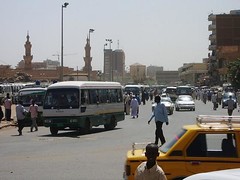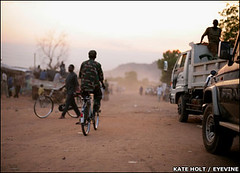How Deep Is the Deep Field?
 For us, aid workers, there is this magical term: the “Deep Field”. It stands for those locations where the real relief work is done. But the “Deep Field” is relative, depending on where you stand. Here I was, leaving our headquarters in Rome for my new assignment in Bor, South Sudan. A place I learned to know as the “Real Deep Field”. How deep can one go, though?
For us, aid workers, there is this magical term: the “Deep Field”. It stands for those locations where the real relief work is done. But the “Deep Field” is relative, depending on where you stand. Here I was, leaving our headquarters in Rome for my new assignment in Bor, South Sudan. A place I learned to know as the “Real Deep Field”. How deep can one go, though? Just before leaving our Rome, I met a colleague who’d just come back from a “field” mission. “Where to?” I said. “Khartoum” he replied. Khartoum, an as-if non-family duty station, is considered by the UN to be an adverse place, bad enough to make you earn the famous hardship allowance. Khartoum, with its international airport, renowned university and air-conditioned houses and shops, is indeed considered a daunting destination by most HQ colleagues waiting for their reassignment. For me, Khartoum was just the first of two transit points on the way to “The Real Deep Field”: my final destination and the frontier to civilization.
Just before leaving our Rome, I met a colleague who’d just come back from a “field” mission. “Where to?” I said. “Khartoum” he replied. Khartoum, an as-if non-family duty station, is considered by the UN to be an adverse place, bad enough to make you earn the famous hardship allowance. Khartoum, with its international airport, renowned university and air-conditioned houses and shops, is indeed considered a daunting destination by most HQ colleagues waiting for their reassignment. For me, Khartoum was just the first of two transit points on the way to “The Real Deep Field”: my final destination and the frontier to civilization.Once I reached Khartoum, the perspectives rapidly changed. Colleagues based in Khartoum felt privileged to be there and looked down upon their unfortunate colleagues who had been chosen for Juba, my second and final transit point and its sub-offices. A colleague from Khartoum confessed to me that he jokingly used “A mission to Bor” as a powerful ‘threat’ with his staff: “How bad could Bor be?” I wondered. Khartoum wasn’t that bad, after all …
 The flight to Juba was pleasant and without surprises. Juba, the capital of South Sudan and one of the three WFP coordination centres in the area, had a more “familiar field look”: a poorly developed place, with loads of challenges. But still a place where the bare necessities could be found. Half of my colleagues were still living in tents. Offices were housed in air-conditioned containers. There was no local infrastructure, rough hygienic conditions and a volatile security situation. But all types of food, drinks and a bit of night life were available. In my first few days in Juba, I felt this was the level of isolation and hardship I was ready to tolerate.
The flight to Juba was pleasant and without surprises. Juba, the capital of South Sudan and one of the three WFP coordination centres in the area, had a more “familiar field look”: a poorly developed place, with loads of challenges. But still a place where the bare necessities could be found. Half of my colleagues were still living in tents. Offices were housed in air-conditioned containers. There was no local infrastructure, rough hygienic conditions and a volatile security situation. But all types of food, drinks and a bit of night life were available. In my first few days in Juba, I felt this was the level of isolation and hardship I was ready to tolerate.At the mention of the word “Bor”, most colleagues in Juba squirmed, compassionate enough not to unveil the final surprise but kind enough to give me some indispensable tips that would prepare me for what was yet to be revealed. Despite it all, I was quite anxious to go to Bor and was still a bit optimistic that at least something was going to be good. Well, my optimism was soon to be betrayed.
When I reached Bor, I felt this was the end of the “known world”. This must be the “Real Deep Field”, I thought. The office, located in a compound on the west bank of the White Nile, did not comply with any of the standing security and operational standards. Food, sanitation and basic living conditions were a mere illusion. I really felt depressed.
Within 24 hours however, I discovered a new world. This was not the “Deepest Field” yet: Bor, is the capital city of Jonglei state, the vastest of the ten South Sudan states, five times the size of Denmark. Bor has its own governor, ministers, a parliament, a police force and a local market where a few basic items could be bought. Those excluded fruits, vegetables and cleaning material, though. It also has a wannabe all-weather airstrip and a hospital run by Doctors Without Borders (MSF).
 All of this wasn’t enough to brighten my spirits until I spoke to one of our field monitors. She was about to go on one of her usual food distribution missions with ninety kgs of luggage. “What are you carrying?” I asked. “A tent, clothes, gum boots, water, basic food for thirty days, charcoal and a few other indispensable items.” she replied. “Why food for thirty days if you are going on a 3-day mission? And what are you doing with the gum boots?” I said. “Well, during the rainy seasons the areas where we operate get flooded. So sometimes, the plane cannot land for weeks and the gum boots are essential to walk in those swampy areas, although sometimes the water reaches more than one meter.” Then I noted she did not have any means of communication and that her tent had holes.
All of this wasn’t enough to brighten my spirits until I spoke to one of our field monitors. She was about to go on one of her usual food distribution missions with ninety kgs of luggage. “What are you carrying?” I asked. “A tent, clothes, gum boots, water, basic food for thirty days, charcoal and a few other indispensable items.” she replied. “Why food for thirty days if you are going on a 3-day mission? And what are you doing with the gum boots?” I said. “Well, during the rainy seasons the areas where we operate get flooded. So sometimes, the plane cannot land for weeks and the gum boots are essential to walk in those swampy areas, although sometimes the water reaches more than one meter.” Then I noted she did not have any means of communication and that her tent had holes.So after all, maybe Bor isn’t the “Real Deep Field!”
Story by Enrico Pausilli, edited by “E” and Peter Casier
Pictures courtesy Ulrik Pedersen and Ben
Continue reading The Road to the Horizon's Ebook, jump to the Reader's Digest of The Road.
 Peter. Flemish, European, aid worker, expeditioner, sailor, traveller, husband, father, friend, nutcase. Not necessarily in that order.
Peter. Flemish, European, aid worker, expeditioner, sailor, traveller, husband, father, friend, nutcase. Not necessarily in that order.
0 comments:
Post a Comment